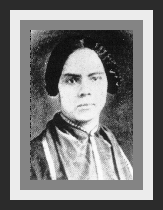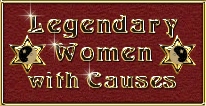
After receiving an education from Pennsylvania Quakers, Cary devoted the first part of her life to abolition, working with fugitive slaves, and becoming the first African-American woman in North America to edit a weekly newspaper -- the Provincial Freeman, devoted to displaced Americans living in Canada.
She then became a teacher, establishing or teaching in schools for Negroes in Wilmington; West Chester, Pa.; New York; Morristown, N.J.; and Canada.
She was also the first woman to speak at a national Negro convention.
During the Civil War, Cary helped recruit African-American soldiers for the Union Army.
She then taught in Washington, D.C., public schools until, in 1869, she embarked on her second career, becoming the first woman to enter Howard Universityís law school.
She was the first Negro woman to obtain a law degree and among the first women in the United States to do so.
She then fought alongside Susan B. Anthony and Elizabeth Cady Stanton for women suffrage, testifying before the Judiciary Committee of the House of Representatives and becoming the first Negro woman to cast a vote in a national election.
As an educator, an abolitionist, an editor,
an attorney and a feminist, she dedicated her life to improving
the quality of life for everyone -- black and white, male and female.
1823--1893
Among the women of the colored race who rendered signal service in the cause of freedom,
the subject of this sketch by reason of the great energy displayed and sincere devotion to the cause,
joined to remarkable intellectual power,
is entitled to stand in the front
rank of that noble band whose virtues and services are the priceless heritage of the colored race.
Few women of any race have left their impression more
indelibly stamped upon the age in which they lived,
or wrought more beneficially than Mrs. Shadd. Mary Ann Shadd was born October 9, 1823,
in Wilmington, Delaware.
It being a slave state she was deprived of obtaining
the education of which her early development gave promise.
At the age of ten years she was taken by
her parents to West Chester, Pennsylvania, and placed in an educational institution
carried on by Miss Phoebe Darlington under the supervision of the Society of Friends.
At the completion of a six-year course she returned to Wilmington,
opened a school and taught colored children.
Some years after, when public school took the place of private tuition,
Miss Shadd taught first in West Chester,
New York City, and Norristown, Pennsylvania.
While teaching in this state in 1850, the infamous Fugitive Slave Act
was passed whereupon she determined to go to Canada
and ascertain what opportunities the country offered
favorable to the settlement of emigrants of colored people from the north and west.
She had seen the effects of slavery on the runaway slaves who found
shelter in her father's home, as they fled to a free state.
Her young soul burned with indignation as she realized the breadth and depth of this moral malaria, this putrid plague spot--slavery.
At first the law--this latest outrage on suffering humanity--was derided and condemned by liberty loving citizens and fugitives did not fear, asserting that they could protect themselves.
This fatal dream was of short duration. Men were arrested and when they resisted or refused to surrender, were shot dead. Many who had been free for twenty years or more, and had in many instances acquired considerable property found themselves only nominally free.
Whole families who had lived for years in freedom were pounced upon at mid-night, beaten and dragged back to slavery.
A growing feeling of humanity stirred the north--a creative force that produced strong men and women as the result of its awakening force.
Colored and white citizens met in private and public meetings, sermons were preached from the pulpits--discussions and resolutions were not unlike the sentiments and expressions of the patriotic outbursts of the American Revolution.
As an act of precaution to preserve their freedom, thousands of men, women and children fled to Canada for safety.
Many had only sufficient means to enable them to reach the land of freedom, and, until they could get employment, would be wholly dependent upon charity.
Miss Shadd located at Windsor, Canada, opposite Detroit, Michigan.
She at once began a vigorous and active campaign by publishing a pamphlet which was widely circulated in the United States, setting forth in plain language the opportunities for emigrants in Canada.
To make her work more effective she returned to the United States and for several years delivered lectures throughout the middle, eastern and western states.
At that time Abbey Kelley, Lucretia Mott and Lucy Stone, anti-slavery lecturers, took their lives in their hands each time they attempted to urge freedom for the slave.
How much greater danger threatened a young colored woman, who publicly sought to aid fugitive slaves to seek a home in Canada and offered the means to carry them there.
So successful was her mission that in 1854 a number of colored men in Toronto assisted her in establishing a weekly paper called "The Provincial Freeman," which was devoted to the interest of the colored people generally, but especially to the fugitives from slavery.
Owing to the vigor and relentless was with which Miss Shadd through her columns attacked the slave interest, the sympathizers of slavery located in Windsor, St. Catherines and on the American border made every effort to suppress the sheet; but for three years she fearlessly braved the storm and thus rendered heroic service, and established her record as the first woman editor of the race, as well as the first educated race woman as lecturer, Sojourner Truth having begun her work as early as 1843.
In 1856 Mary Ann Shadd was united in marriage to Mr. Thomas F. Cary of Toronto.
After marriage she and her husband resided in Chatham, Canada West.
But her public career was by no means ended.
Stirring times for the nation and the race were just ahead. She continued to be friend and helper to the refugees.
One Sunday a slave boy without hat, coat, or shoes who had thus far eluded his pursuers, was overtaken in Chatham and about to be carried off.
Mrs. Cary tore the boy from the slave hunters, ran to the court-house and had the bell rung so violently that the whole town was soon aroused.
Mrs. Cary with her commanding form, piercing eyes, and stirring voice soon had the people as indignant as herself--denouncing in no uncertain terms the outrage perpetrated under the British flag and demanded that these man-hunters be driven from their midst.
The result was that the pursuers fled before the infuriated people, happy to get away without bodily harm; and so this insolent slave-power, this monster of hideous mein, was rebuked as he sought to pass the bounds of the prison house and darken the realm of light--even the free air and soil of Canada.
In 1858 John Brown and his companions went to Chatham where on the 8th of May they held a Convention and adopted a "Provisional Constitution,"--John Brown the brave and heroic who went to seek those who were lost that he might save them. He found many who aided him in his daring project.
And when the great blow for freedom had been struck and the tragic end had come in 1861, the subject of this sketch compiled the notes of Osborn P. Anderson, sole survivor of the Raid, entitled a "Voice from Harper's Ferry." At the beginning of the Civil War, Mrs. Cary was teaching school in the State of Michigan.
In 1863 a call for 500,000 men was issued by the government.
Mrs. Cary with true patriotic fervor, which had always characterized her actions, was on August 15th appointed by special order, Recruiting Army Officer , to enlist Colored Volunteers in the Union Army. She accepted the commission from Governor Levi P. Morton of Indiana and actually assisted in recruiting a regiment of soldiers for service at the front. At the close of the war Mrs. Cary moved to Washington, D. C., where she served as teacher under the direction of Howard University.
Later she was appointed in the public school system of Washington, D. C., and for seventeen years served as principal of three large schools. At the same time she was a regular contributor to newspapers: The New National Era , edited by Frederick Douglas, and The Advocate , edited by John Wesley Cromwell.
In 1881 she became an active member of the National Woman's Suffrage Association.
Being progressive and energetic Mrs. Cary entered the Law Department of Howard University and was graduated in 1884.
She resigned from her school activities to devote her time to the profession of law, in which profession she met with notable success to the end of her life.
Mrs. Cary died in Washington, D. C., June 5, 1893, sincerely mourned by all who knew her and her sterling worth.


Image (PICTURE DONE BY, National Archives of Canada number C 29977 NATIONAL WOMENS HALL OF FAME http://www.greatwomen.org/
MICROSOFT Encyclopedia Encarta on line